#1870s extant garment
Text
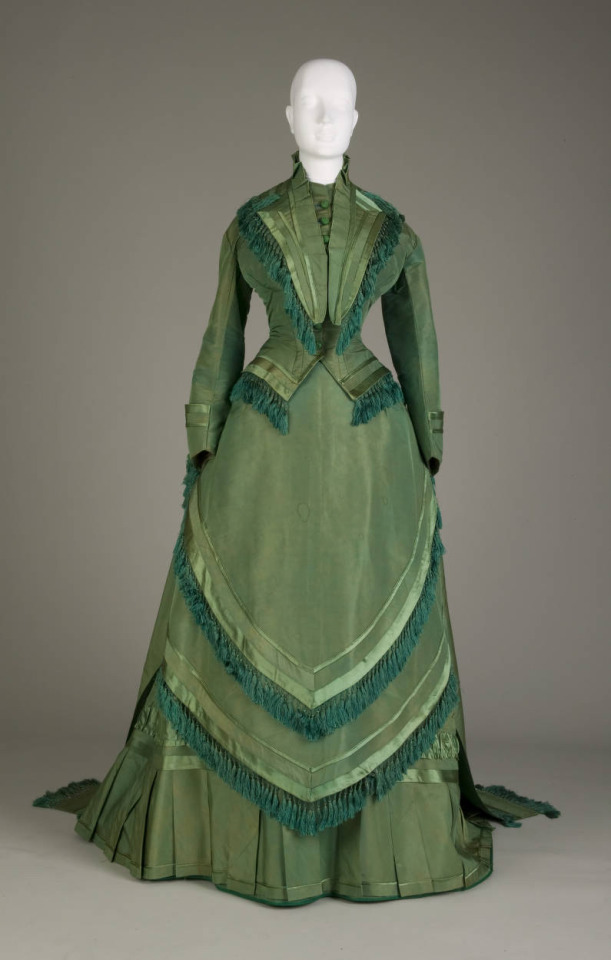
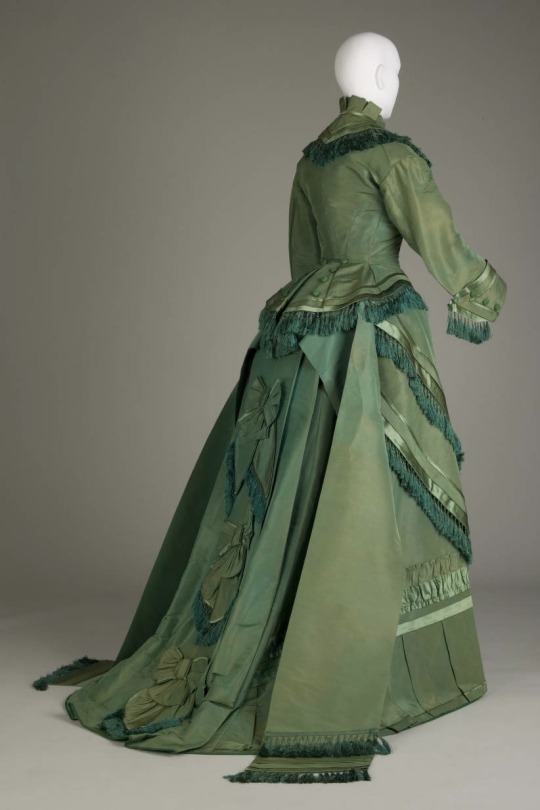
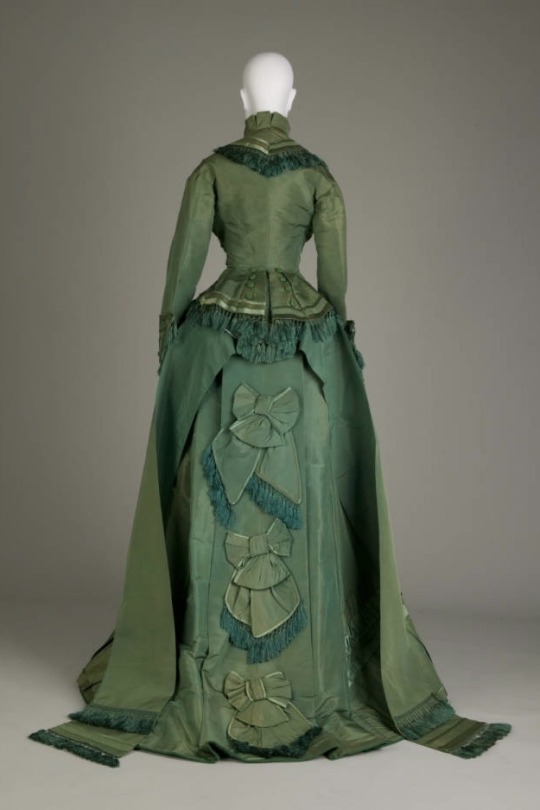
Green taffeta wedding dress, 1874, American.
Worn by Harriet Elder.
Chicago Historical Society.
#womenswear#extant garments#dress#silk#taffeta#19th century#chicago historical society#green#USA#1874#1870s#1870s dress#1870s usa#1870s extant garment#Harriet elder
298 notes
·
View notes
Text



Dress by the House of Worth, 1877
From MFA Boston
2K notes
·
View notes
Text
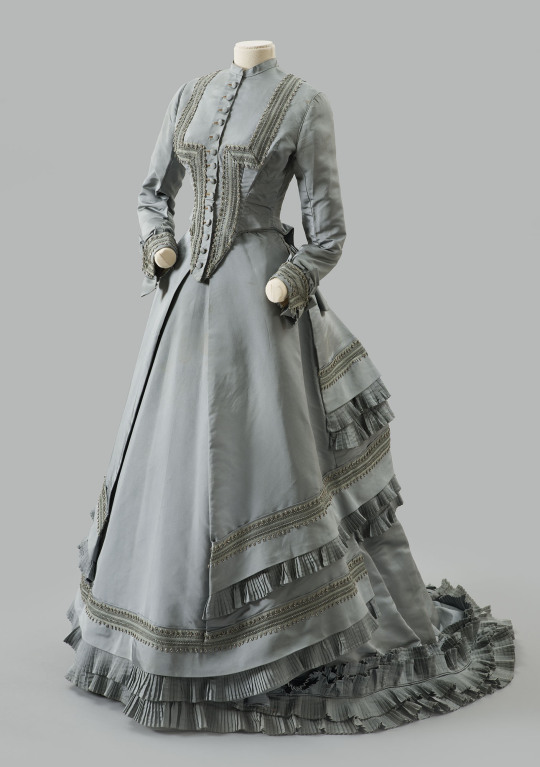
House of Worth gowns have a tendency to be all out in terms of colors and patterns, but I love that this dress plays with the monochrome palette and leaves the details for the tailoring. Dating from 1873, it's got the silhouette of the times you'd expect but with the high-neck conservatism of the next decade. I love the ruffles and diagonal lines along the hem and bustle. According to the description, it's silk faille taffeta and trimmed with steel beads. Just stunning! I love everything about this dress.
From the Albany Institute.
#historical costuming#costume history#silk dress#textiles#victorian fashion#late victorian fashion#fashion history#threadtalk#costume#history of fashion#1870s fashion#early 1870s#extant garments
915 notes
·
View notes
Photo


Walking Dress
Attr. to Charles Fredrick Worth
1876-1882
The MET (Accession Number: 2009.300.6291a, b)
#walking dress#fashion history#historical fashion#charles fredrick worth#1870s#1880s#house of worth#19th century#bustle era#off white#cotton#linen#lace#france#the met#me seeing a photo of someone wearing an extant garment:#oh the followers are going to have THOUGHTS#at first i was like is this really a walking dress#and then i was like if you can afford Worth#your walking dress is probably going to look like this yeah
147 notes
·
View notes
Note
Your post about the Victorians’ attitudes towards the Regency is so interesting!! Do we have any examples of them satirizing or otherwise lambasting the attire of other eras? My teacher once said they hated the Georgians but I’ve also read that was a big 1870s influence so unsure if that’s right.
I think this is where it helps to remember that the Victorian EraTM was a 60-year span of time, and the Georgian era similarly expansive. Parts of it were in and out of favor during parts of the former, so it's not quite correct to say "the Victorians hated the Georgians."
(Also, for fellow non-Brits who were confused by the Georgian/Regency distinction like I first was: the Regency was part of the Georgian era. So were most of the 1820s and 1830s. Georgian does not just refer to the panniers/powdered wigs period. The more you know!)
There was a massive late 17th/early-mid 18th-century influence on fashion in the 1870s and 80s, yes! It's why I get annoyed when people claim that bustles are based on the- very real -exploitation and fetishization of Sarah Baartman (c. 1789-1815). They became popular nearly 60 years after her death, and took inspiration from clothing that went out of style decades before she was born.

(La Comtesse de Mailly, 1698)
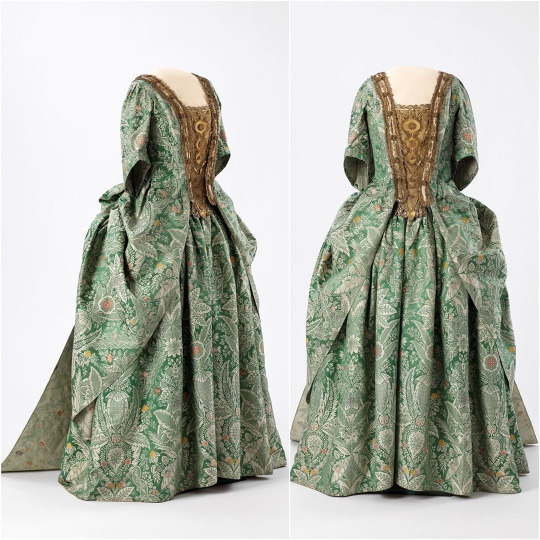
(1720s dress, National Museum, Norway.)
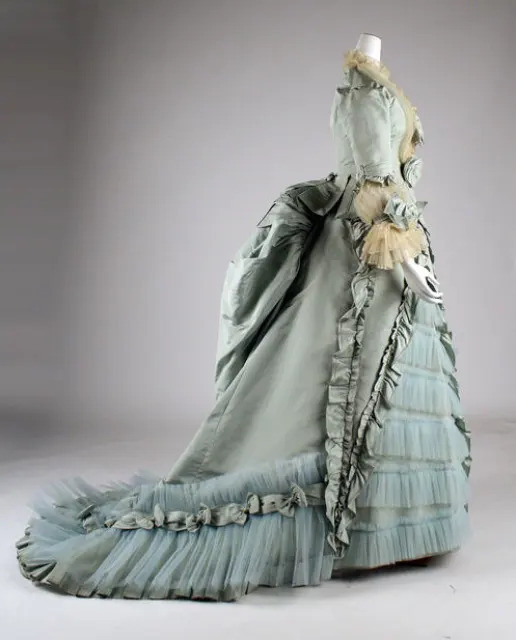
(Gown from the Met Museum's collection, c. 1872. Note the ruffled 3/4 sleeves, skirt back fullness, and appearance of an underskirt/overskirt arrangement. Low-ish, square necklines were also popular at the time, though not universal.)
As for satirizing other eras of fashion, I'm sure it happened in abundance; what interests me more, however, is the spreading of outright misinformation about how their ancestors dressed. One of the best-known examples is their take on the "iron corset" of the Medieval and Renaissance periods:

(Illustration from The Corset and the Crinoline, published 1868. One 1871 writer from the London Times dismissed the notion that such garments were orthopedic devices as "superficial falsehood," despite the fact that we now know- and clearly at least some people did back then, too! -that primary sources identify them exactly that way.)
While real examples of iron support garments do exist- as do extant accounts identifying them as medical aids -a roaring reproduction trade sprung up during the Victorian era. At least partially for fetish reasons, it is now believed, echoing the anonymous tightlacing erotica found in such publications as the misleadingly-named Englishwoman's Domestic Magazine.
And that's just one example. The more things change, the more we remain convinced that our ancestors were complete idiots who had no idea how to dress themselves sensibly.
#ask#anon#marzi rambles#long post#dress history#victorian#georgian#history misconceptions#fashion history
82 notes
·
View notes
Note
May I ask what your Totoro inspiration tag is for? I love Totoro and 1870s dresses and I am baffled and delighted by the apparent combination.
A few years ago I was struck by the idea of making an 1870s interpretation of Totoro for wearing to conventions etc. But it requires a ton of work for all the foundation garments and also a dressform and in the meantime I've had three addresses and two kids and not enough cash, so it's sort of permanently tabled until I move less often and have a workshop and also somewhere to wear it. I'm collecting extant examples and plates so I can steal necessary elements when the time does eventually come.
3 notes
·
View notes
Text




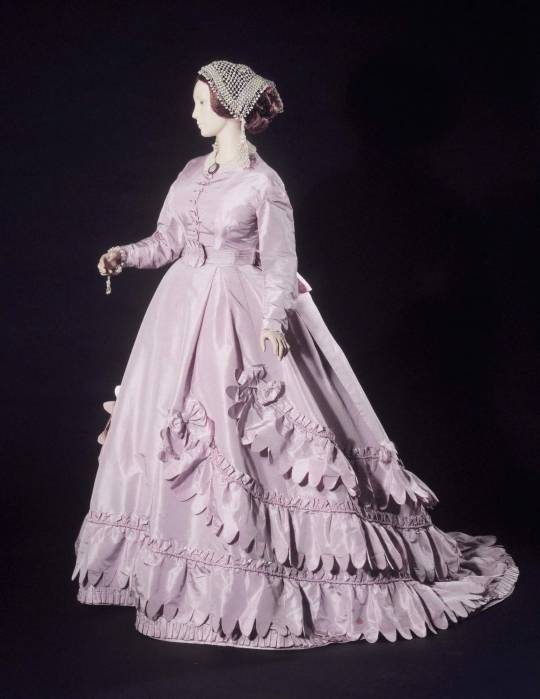

D'Artagnan.
"It is Lilac time and this is one of my top favourite jewels; it is so real you can almost smell it
This exquisite piece was made in 1862 by the French Royal Jewellers Mellerio dits Meller and was first unveiled at the 1862 Universal Exhibition of London. The life-size gold, diamond, and enamel piece perfectly imitates nature with different shades of enamel to render the buds and the flowers and a guilloche technique on the leaves creating an illusion of wilting.
I wonder what kind of garment would be worn with it ? The designer Charles Frederick Worth (1825-1895 ) comes to mind but I cannot find many early extant gowns of the period so I have settled for this Ensemble from the Met museum dated 1862 -1865.Although the dating seems a bit too early more like the latter part of the decade .
This is a rare example designed by Worth and his partner Otto Bobergh from 1858 -1870.
#1 Brooch by French Royal Jewellers Mellerio dits Meller first unveiled at the 1862 Universal Exhibition of London. The life-size gold, diamond, and enamel piece perfectly imitates nature with different shades of enamel to render the buds and the flowers and a guilloche technique on the leaves creating an illusion of wilting. © Musée d’Orsay and Mellerio dits Meller
#2 #4 #5 #6
Ensemble from the Met museum dated 1862 -1865.This is a rare example designed by Worth and his then business partner Otto Bobergh from 1858 -1870.
The elegant garment in lilac silk has two bodices and a multiplicity of trimmings so typical of Worth I must confess I am not too keen on the evening bodice with the squared tabs at the front which seem little at odds with the scalloped edge self trimmings.
Another thing to note is regarding the colour of the gown. Picture #6 from the Met illustrates a very deep colour somewhat at odds with their other photos. I have taken the liberty of adjusting the colour to look more in keeping with their other images .Please Forgive Me Met Museum © acknowledged .
https://www.metmuseum.org/art/collection/search/156080
~~~oOo~~~
Mellerio dits Meller, is the oldest family-run jeweller in Europe. Originally founded in 1613, the period of the Second Empire was a time of great productivity for the Mellerio family. Some of their most audacious creations were created in this short period of history for a very discerning clientele that included the Emperor Napoléon Bonaparte and his wife, Empress Eugénie, Princess Mathilde of France, the aristocracy and the Royal Courts of France.
but also writers, composers, actresses, and socialites.
Inspired by the natural world, the Orient and innovation, during in the Second Empire they produced life like spectacular jewels that imitated nature.The firm also invented settings en Tremblant to create the illusion of movement
Love D’Artagnan xxx".
0 notes
Note
Hello, if you are free. I would love to hear your thoughts and analysis on the costumes of "Story of Yanxi Palace" (2018) and the sequel "Yanxi Palace: Princess Adventures" (2019)
Hiya! I'm probably not the most qualified person to talk about Manchu fashion or court dress but I'll try my best😭
Story of Yanxi Palace (2018) 延禧攻略
Story of Yanxi Palace (Chinese: 延禧攻略) is a Chinese period drama series recounting the struggles of a palace maid in the court of the Qianlong Emperor. It was created by Yu Zheng, with original screenplay written by Zhou Mo, and later developed into a novel by Xiao Lian Mao. Starring Wu Jinyan, Charmaine Sheh, Qin Lan, Nie Yuan, Tan Zhuo and Xu Kai, the series premiered on iQiyi from July 19, 2018 to August 26, 2018. During its run it was streamed more than 15 billion times. (copy and pasted from Wikipedia) For the costuming it should be noted that the timeline of the show starts in 1741, the early Qianlong era. The story takes place in court, meaning that most characters are Manchu and wear Manchu fashion and court dress.
A bit of context for those unfamiliar with the Qing: the royal family (and the aristocracy in general) in the Qing were ethnically Manchu, whereas the majority ethnicity in China both back then and nowadays is Han Chinese. Han and Manchu men shared the same fashion system while the clothing of Han and Manchu women remained distinct; I’m more knowledgeable about Han women’s fashion so I can’t guarantee that everything I say about Manchu womenswear is legit... In the Qing court, clothing worn to formal occasions followed official regulations, meaning they were different to casual fashion----this is, I think, very important to distinguish.
All the screenshots are from the Youtube uploads.

Source here
So, um, just from the posters and promotional photos alone I could tell that some of the costumes are not from the 18th century... The overall vibe of the costumes in this show resemble the mid 19th century, particularly the mid 19th century because there are quite a couple images and extant garments from this era.

Two minutes in and I have a lot of questions. Why are the ladies wearing gowns with this loose, white 挽袖 wanxiu (folded cuff) design? The relaxed sleeve width is from the 19th century, in the 18th century when folded cuffs were worn they were usually more form fitting. In the mid 18th century, formal Manchu women’s gowns like 吉服 or 常服 had slender sleeves with 马蹄袖 matixiu or “horse hoof” cuffs, whereas informal gowns had either horse hoof cuffs or straight sleeves that were also very tight fitting. Also the super low collar is very late 19th century Han women’s robe, again incorrect for both time and ethnicity. Manchu clothing was originally collarless but in the 18th century some Manchu ladies added collars to their robes or wore fake ones; these would look similar to those on Han women’s clothing at the time, soft (unstiffened), tall and closed with two buttons. The lady in brown is wearing a 巴图鲁坎肩 batulu “warrior” vest, a vest that could be opened from the front and sides, that screams 19th century as well. Her hair with the 燕尾 yanwei or “swallow tail” bun at the back is incorrect; swallow tails were worn by Han women in the late Ming and some eras in the Qing and were not coopted by Manchu women until the friggin turn of the 20th century. I genuinely do not understand the need to give every Manchu lady a swallow tail in these period dramas, it’s wrong for the era and ethnicity and generally makes no sense.

Source here
Portrait of Empress Xiaoshen from the Daoguang era (1821-50) wearing a 衬衣 chenyi robe similar to that in the screenshot with a kerchief.

Source here
乔园之三好图 from the 1670s or 80s showing Han women in swallow tail hairstyles.

Source here
1870s or 80s photograph of a Han woman wearing a robe with the super low collar.

...ladies, gentlemen and non binary fellows, we have arrived in the mid 19th century. Everything, from the 两把头 liangbatou hairstyle that looks like a landline telephone, the red strings tying the hair together, the flowers in the hair to the cut and decoration of the chenyi and low collar with binding, literally everything except the swallow tail is directly lifted from the mid 19th century. Qianlong is spinning in his grave so fast he can power the Forbidden City. The costumer even gave them incorporated 云肩 yunjian or cloud collar designs, which were more of a Han thing, to further spite him.
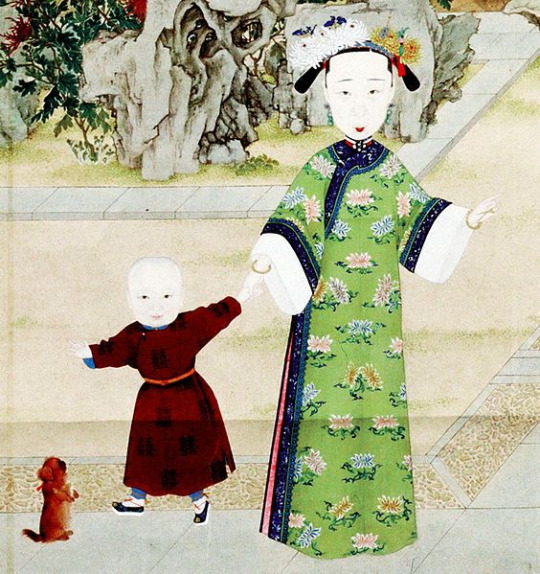
Source here
Portrait of Empress Xiaojingcheng from the Daoguang era (1821-50).

Source here
Mid 19th century Han women’s robe with an incorporated cloud collar design.

Source here
Mid 18th century painting showing Manchu women. This is probably later than the 1740s and less realistic because it’s a Cantonese painter’s understanding of Manchu fashion but the women in Yanxi Palace should still look more like this than whatever was going on in the 1850s. You can see their sleeves are tighter and more form fitting. The 钿子 dianzi (more on that later) they’re wearing is commonly believed to have evolved from braided hair covered with a turban. In the 17th century and before, Manchu women used to wear braided hair in a bun, and that was likely the precursor for this hairstyle which was in turn the precursor to dianzi and liangbatou.

Source here
You can see the hair bun covered by cloth better in this painting, 春闺倦读图轴 by 冷枚 Leng Mei depicting a fashionable Manchu lady. The painting is from 1724 so maybe not exactly appropriate for Yanxi Palace, but you can clearly see similarities and continuity with the previous painting. You can also see that she’s wearing another garment underneath to which the standing collar is attached.
I do really appreciate how they arranged the flowers on the liangbatou in an asymmetrical way and how the flowers are relatively small and delicate. Asymmetry was the soul of the liangbatou hairstyle in the 1850s. In older dramas, Manchu women would usually wear a giant 旗头座 qitouzuo (artificial hair base) with an equally giant flower right in the middle, and a bunch of tassels and small decorations everywhere. That style did not become a thing until the turn of the 20th century, even then it wasn’t that insane.
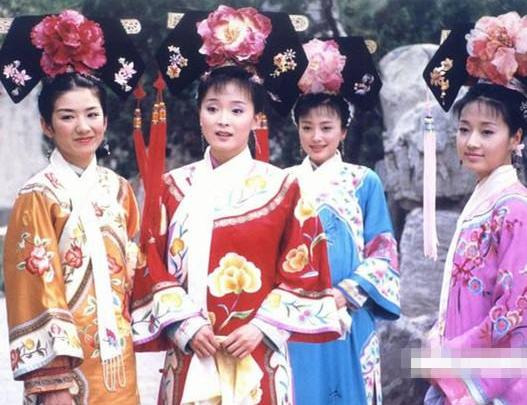
Source here
Older dramas be like. I swear this look needs to be on the Qing Dynasty costuming board of shame; it was so wildly incorrect but so popular and led so many people down the wrong way...

Source here
Old photograph of a Manchu couple from 1917. The flower is nowhere as big and there are no excessive decorations. This looks kind of like a special occasion photograph though? Normally Manchu women wouldn’t even wear giant flowers on the liangbatou (alternatively 大拉翅 dalachi or 旗头 qitou).

Source here
Another photograph from the 1900s/1910s showing liangbatou without the giant flower.

This is kind of interesting. The coat is probably a 吉服褂 jifugua (jifu coat), a black-ish blue coat with 八团 batuan or eight roundels design worn over a jifu robe. Jifu was a ceremonial ensemble that saw a lot of daily use in the Qing court, so I guess this occasion was appropriate. She has the horse hoof cuff on the robe underneath which is legit. She’s wearing a 领约/项圈 lingyue/xiangquan necklace which did exist though I’m not sure if it would’ve been worn with jifu. The headpiece is maybe going for a 钿子 dianzi impression, though I haven’t seen any dianzi which is completely gold. Dianzi was not the sole headwear for jifu though, in the Qianlong era jifu was still commonly worn with 吉服冠 jifuguan (jifu headpiece, the red hat with a jewel on top). Either that or it was supposed to be a 凤冠/翟冠 fengguan/diguan worn by Han women. As to the fake standing collar, ummm it was doable but not necessary or common in the 18th century. Manchu women’s clothing was originally collarless and did not become unanimously with collar until the 19th century. Jifu was also commonly worn with a fur trimmed collar, not the “Peter Pan” style as shown here. The frequency at which standing collars appear in this show is a bit sus.

Source here
Closeup of 崇庆皇后万寿图 from 1751 showing court women in jifu coats.
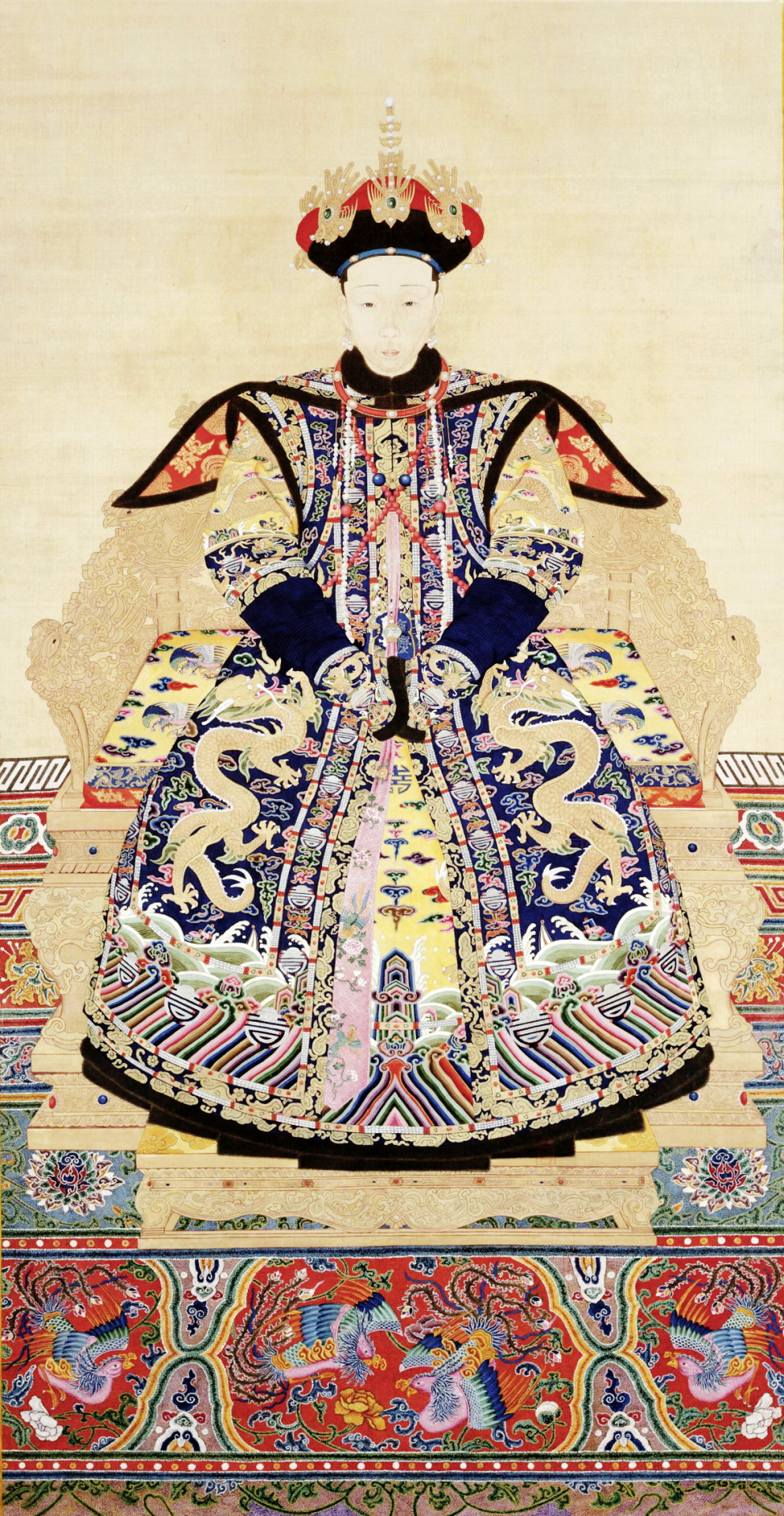
Source here
Portrait of Empress Xiaochunyi in a 礼服 lifu, the most formal ensemble, wearing a lingyue (the solid circular necklace). Lingyue is more commonly seen in portraits with lifu and not jifu.

Source here
Qianlong era (?) painting showing Manchu ladies wearing informal robes with fake collars, dianzi and lingyue. Not jifu.

This headpiece is probably supposed to be a dianzi this time. The shape and size look legit. The individual decoration pieces could be added according to personal preference, so there isn’t much that could go wrong. Extra cookie for the 一耳三钳 yi’ersanqian or row of three earrings, that was a very distinctly Manchu accessory. I'm not sure whether it’s appropriate to have the emperor (I assume it’s Hongli here) in a 礼服 lifu, this ultra ceremonial outfit, for an occasion like picking court ladies.
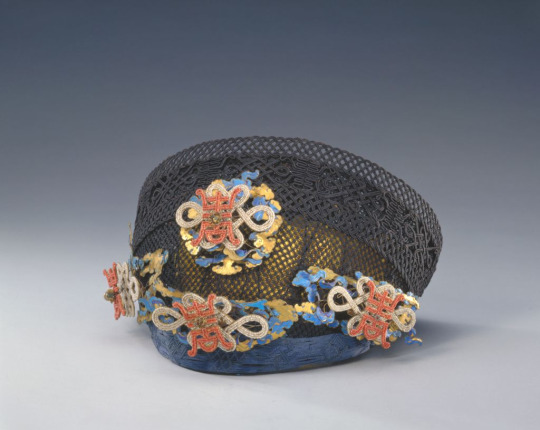
Source here
Extant dianzi. Dianzi are usually made of fabric braids and metallic threads that form a solid base for decorative pins, very much like the diji I mentioned in my Song of Youth review.

The inside of the lady on the left’s outfit revealed by the slit in the jifu coat is pretty great. It looks like a standard jifu robe with eight roundels and 海水江崖 haishuijiangya or waves and cliffs motifs.

Source here
Similar extant jifu robe from the Qianlong era.

This lady is not Han for all I know but wears an actual cloud collar, which fell out of favor in the early 18th century as casual fashion and became a garment in formal wear. Manchu women did sometimes borrow items from Han fashion and wore cloud collars but it wasn’t so common at all.
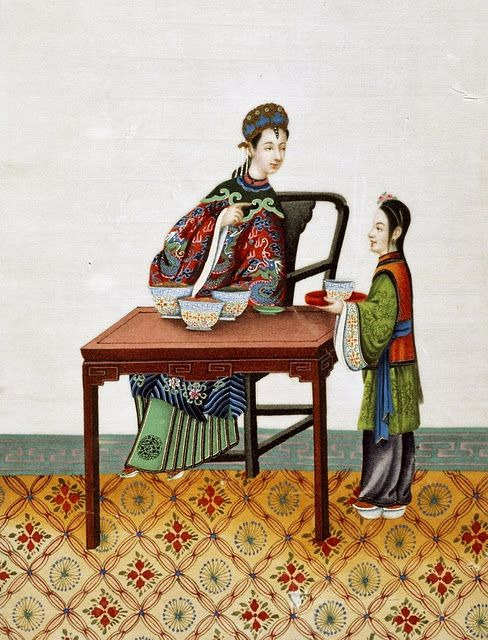
Source here
Daoguang era (1821-50) export painting showing Han woman in formal attire wearing a separate cloud collar.

Source here
Mid 19th century Manchu lady wearing a cloud collar.
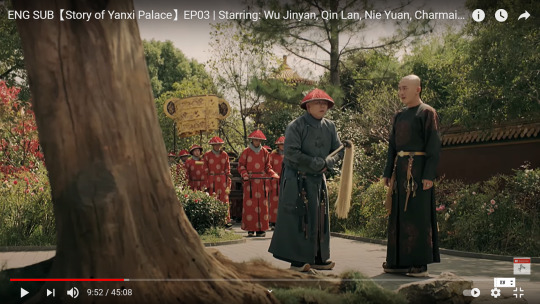
YES! The emperor is finally allowed to wear something other than the friggin yellow lifu!! The guy on the right is supposed to be Qianlong and he’s in a collarless informal robe which! has! four! slits!!! Great period detail omg. The standard men’s robe would have four slits (sides, front and back) when worn by the emperor. I would prefer if it had horse hoof cuffs though.
I skimmed the next couple episodes and it seems like there’s not much else to say about this show, the costumes pretty much stay the same (they never got out of the 1850s). This show really got me wondering something though. You know how in recent years everybody loves Qianlong era fashion so much to the point that costumers insert bits and pieces of Qianlong era Han fashion into shows set in the Ming Dynasty? Well, for Yanxi Palace they finally get to actually do the Qianlong era and they suddenly... don’t. They suddenly want to sashay off into the 19th century now. I...
However, despite the incorrect time period and all the minor questionable things, I am beyond thankful for this drama since it kind of started the trend for more historically accurate dramas (Imperial Doctress 女医明妃传 from 2016 was the inciting incident and this and Ruyi’s Royal Love in the Palace 如懿传 was the point of no return). I also cannot be grateful enough for the first ever Qing court drama that dared to explore Qing fashion beyond the 1910s and did not use stereotypical Manchu women’s outfits you can rent from any costume shop for less than 10 euros. This show is going down in Chinese period costuming history I’m calling it now. Well it’s already iconic. Overall I’d give the costuming a 4/10 for the batshit crazy time travelling, though if it were set in the mid 19th century I’d honestly give it 8/10.
Once again just to give you an idea of how shite Qing court drama costuming used to look, I will show you some images that give me psychic damage.
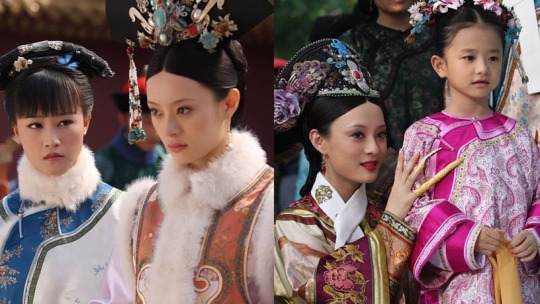

Source here

Source here
Empresses in the Palace 甄嬛传 (2011). Wtf is going on? Not even brothels in belle époque Beijing turned looks like these. Growing up as a child watching these dramas I always felt really sorry for the emperor cause he’s the emperor of China but could only wear one or two outfits. As a preteen in the early 2010s who shopped exclusively at Forever 21 I had a more interesting wardrobe than he did. God I love tearing the costuming in childhood dramas to shreds. If y’all want me to go feral on any old dramas my askbox is always open :)))) Actually no, because there isn’t much to say besides that they’re all shite.

Source here
Palace 宫 (2011).

Source here
Scarlet Heart 步步惊心 (2011). Did something go down in 2011? Why is it out to get me?
Anyway here are some articles about Yanxi Palace that explain everything better than I did, thought they’re all in Chinese: x, x
The sequel hasn’t aired yet to my knowledge and the costumes don’t look that great so I won’t talk about it here. Maybe when it airs we can make fun of it together :3
#costume analysis#story of yanxi palace#chinese fashion#historic fashion#19th century#qing dynasty#Manchu clothing
323 notes
·
View notes
Text
Historical Accuracy of Costumes in Period Films - Enola Holmes
Disclaimer: I will put no spoilers so you can still read if you haven't seen the movie yet! This post is just me assessing the costumes and their historical accuracy.
First of all, since the movie came out I had already heard a lot about it in just those two days that I was very curious to see if it lived up to the hype and it truly did! It's well-made with round characters and a gripping story line. But enough about the movie, let's get on to the costumes.
The movie is set in 1884, and at first I thought she was born in 84 (because of the intro) so I did like a third of the movie thinking the costumes were outdated until I looked at a closeup of a newspaper and realized that it is set in 84, so yay for me. But anyways, here are the facts.
Enola is 16 years old, therefore considered a child/young woman in society and would be wearing children's clothing but we'll get to that later
There aren't many examples of children's clothing from that time so I'll have to refer to the few fashion plates that I can find.

This blue dress from the beginning of the film has basically everything one would expect from the very end of the 19th century, but not necessarily the 1880s. The loose front is a very end-of-the-century, more so even Edwardian thing, and from the fashion plates and magazines I could find it seems that children's clothing was heavily inspired by adult fashion. It has a very low waistline and is overall very straight. Enola's dress looks more 1900 except for the fitted sleeves which are accurate for the period. And the collar looks completely out of place. But, of course there’s always a but, this is just taking mainstream fashion into account. The Aesthetic Dress movement took place in the 1880s and the dresses would have looked somewhat similar to this one, with a loosely fitted front but they also had puffier sleeves, so it’s like they took some details from different movements and also took some inspiration from the Edwardians and put them all together in a dress.
Another thing I would like to add, (hence the advert - I had to make collages to fit 10 pictures in this post) I am not sure as it doesn't fit her character at all but she looks corseted in those pictures (I added the first one specifically because I think you're able to see the outline of a corset? Faintly?). Depending on your age and status and your parents' plans for you (aka if they wanted you to get married at 16), teens of that age would either wear a corset or not. But taking Enola's upbringing into account and it was rather uncommon for a 16 year old to be wearing a corset, not unseen but uncommon, I'd say that if the costume department decided to put Millie in a corset in that particular scene is historically inaccurate. There were corsets for young women/teens, but they didn't give you that extreme hourglass shape, they were straighter and didn't give you a tiny waist, like the bottom right one in this corset advert. Unfortunately, I could not find out when it's from but it should be somewhat close to the 1880s.
Next up, I would like to say that the length of the skirt they chose for Millie to wear is appropriate for a 16 year old! Unlike what we saw on Anne with an E...

At one point we get a look at her undergarments and they're looking fine for the time! The chemise and the drawers, she's obviously not wearing any petticoats as she's being measured but we saw a glimpse of a petticoat when she was riding a bike in an earlier scene so yes, this part is accurate.

Next up, I'd like to talk about this lady and her dress is just amazing, fashion plate worthy and absolutely accurate, I have nothing bad to say about this.

What I noticed overall in the movie was that the bustles weren't as extreme as I would have expected them to be, but it all had to do with personal preference so it's not necessarily historically inaccurate to see more lowkey bustles. But I didn't see one bustle that was just crazy in today's eyes so maybe they could have improved on that but I'm just nitpicking at this point. Or maybe I've just gotten so used to seeing old clothes that nothing shocks me anymore.
Here we can see some crinolines being sold and judging from their width they are somewhat outdated.

They could pass as maybe early 1870s if not even 1860s.
Now Enola wants to become a lady, so she has to wear adult clothes! Here, she goes into a shop and puts on her clothing. We can see here how poorly fitted the corset is; the lacing gap should be parallel but you can see in the mirror how it gets smaller towards the bottom. Maybe it was done unintentionally but maybe it's just supposed to show that ready-to-wear corsets just weren't made for the person buying them. But in that same scene, we finally get a proper bustle! That's historical accuracy right there!

Next up is her iconic red gown.

Now... I had a little bit of trouble with that one. The skirt is a little wide in my eyes, but the overall shape and cut is fine, with that layer draping over her underskirt. However, her neckline is something you wouldn't typically see. You see other characters wear high necklines, so I don't know why they chose to give this dress almost an evening wear look. V-necks did exist in evening wear, but then again they would be paired with frilly short sleeves and not tight fitting day wear sleeves. So all in all, yes, the dress is accurate but the neckline is uncommon.
Next, we have what is probably the most accurate one of her costumes – the mourning gown.
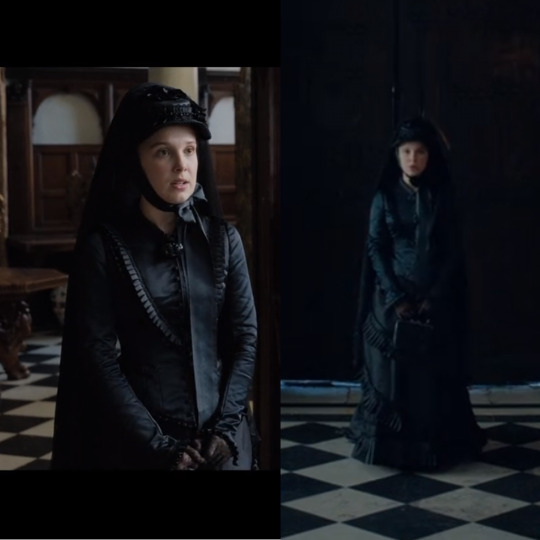
It's slimmer than the red one and there are so many examples of extant garments on google pictures that look so similar to hers that I'm just gonna say, excellent job!
Next is my favorite despite the neckline problem. She just looks so pretty in it!

The neckline isn't as low as on the red one but still quite uncommon. Another detail you can see in the second picture is that she seems to be wearing a bum pad instead of a bustle, which I think is acceptable. It's slim, it has a layer that drapes over the underskirt in the front, and even the sleeves are a little bit gathered at the top which was very common.
And lastly, we have this white dress where she goes back to the style she wore at the beginning of the movie.
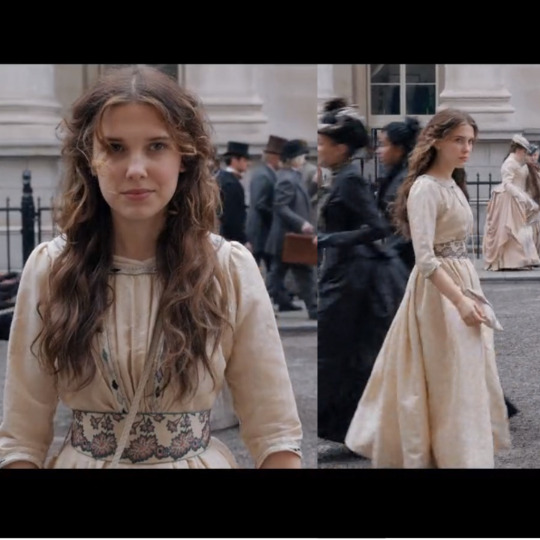
And once again, just like I said in the beginning, this is not something you’d really see being worn in that time unless we’re talking about the Aesthetic Dress and now the sleeves aren’t as fitted so it makes sense for the movement, plus it’s kept very simple.
Overall you can say they did a fairly good job at making everything historically accurate but took some artistic liberties here and there, just like you would expect from a movie.
#enola holmes#sherlock holmes#millie bobby brown#victorian fashion#fashion history#historical fashion#period movies#enola#1880#19th century#1880s fashion#corset#fashion#victorian
1K notes
·
View notes
Text
I have fallen down a rabbit hole of fashion plates. Let's just - let's just have my Top Five fashion periods, yes?
#5. the 1850s
The era in which full skirts became a Thing and then crinolines were invented. A+++ social distancing. Also crazy curls and BONNETS? A++ would reccomend.
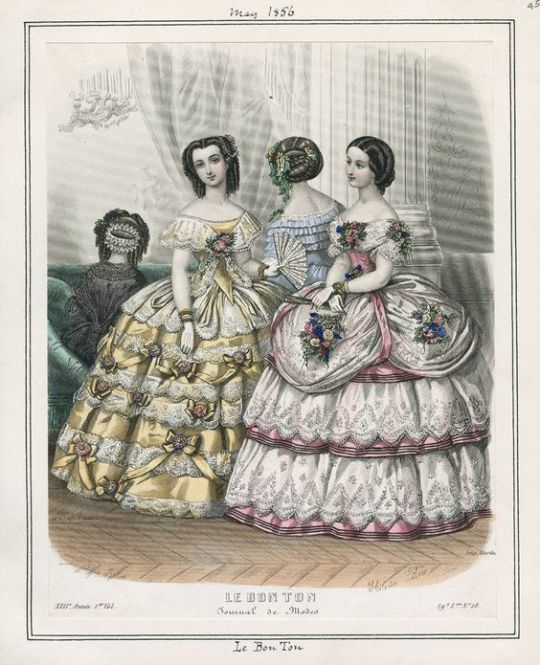
Fashion plate from Le Bon Ton: Journal de Modes, 1856.
#4. the 1900-1910s lingerie dress/gowns
People got a little extra with the lace in this period not gonna lie. It's glorious. These dresses were usually made of cotton batiste or cotton lawn, or other lightweight, sheer, and breathable fabric. Oh and don't forget obscene amounts of lace. Like. I could never afford that much lace on one single dress ohmygod.

Cotton batiste lingerie gown, 1900-1910, via Augusta Auctions.

Photo of a girl in a lingerie dress, 1900-1910, probably Russian.
#3. the 1870s aka the First Bustle Era
No need to ask your mother if your bum looks big in this. She'll probably say that it's not big enough anyway. The amount of Extra™ is really Just Right. Just - look at them.

Fashion plate from Le Moniteur de la Mode, 1872.

Fashion plate from Revue de la Mode, 1873.
#2. the 1820s
I'm pretty sure I've established that I am Extra™. Usually people just lump this decade into the Regency but no??? George was already king and the silhouettes aren't even that similar. The waistline in the 20s were gradually shifting downwards, in contrast to the extremely Extra™ (but not to my taste) shelf bust of the height of the Regency. People got a little crazy with the trim because the Napoleonic Wars were over and people had more spare money to spend on Extra™ things. Do not get me started on the Rouleaux trims.

Ball dress by John Bell, 1821, via Los Angeles County Museum of Art.

Fashion plate from La Belle Assemblée 1842, by John Bell.
#1. the 1830s aka the Romantic Era
Surprise surprise. If you thought that the 20s were Extra™ please consider this:

Fashion plate from Ladies' Pocket Magazine, 1832, via Los Angeles County Museum of Art.
The hair was Extra™, the bonnets were Extra™, the silhouettes were Extra™, the trimming was Extra. This is one of those fashion plates where I see it and go "That looks so crazy I must make one". And they're not hard to make. Giant rectangles for the skirt, half-circles for the sleeves and the most complicated part is the relatively simple bodice. And I get to jazz it up with lace and sparkly things. It's all the best parts of historical dressmaking in one.
Here, have another:
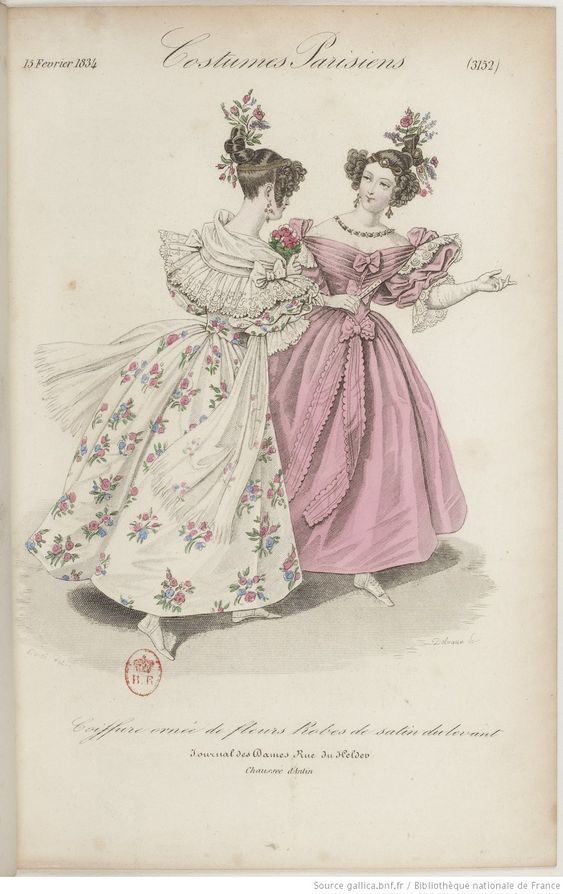
Fashion plate from Costumes Parisiens: Journal des Dames et des Modes, 1834.
And as a bonus for bearing with me until now, have a Cancelled™:
Regency court dresses.

And this is one of the relatively okay ones.
Yes, the court dresses in Bridgerton were very pretty, and yes, they were probably the most historically accurate out of their many, many costumes, but they were, unfortunately, French. The British ones looked like that. And this. And this. And all this. The literal lovechild of a Regency empire waist dress and a panier because the queen thought that the fashionable silhouette was too informal for court. Let's just say Queen Charlotte had approximately zero (0) taste.
Find more 1820s fashion plates and extant garments here, and Victorian ones here. Lady Rebecca Fashions on YouTube has a wonderful video on Regency court dresses here, and Pinsent Tailoring has a little bit of a meltdown over the men's costumes and talks about those godawful court dresses in this video.
#dress history#fashion history#daisy talks history#history#historical fashion#1850s fashion#1900s fashion#1870s fashion#1820s fashion#1830s fashion#regency court dresses#victorian fashion#regency fashion#bridgerton#long post
9 notes
·
View notes
Text
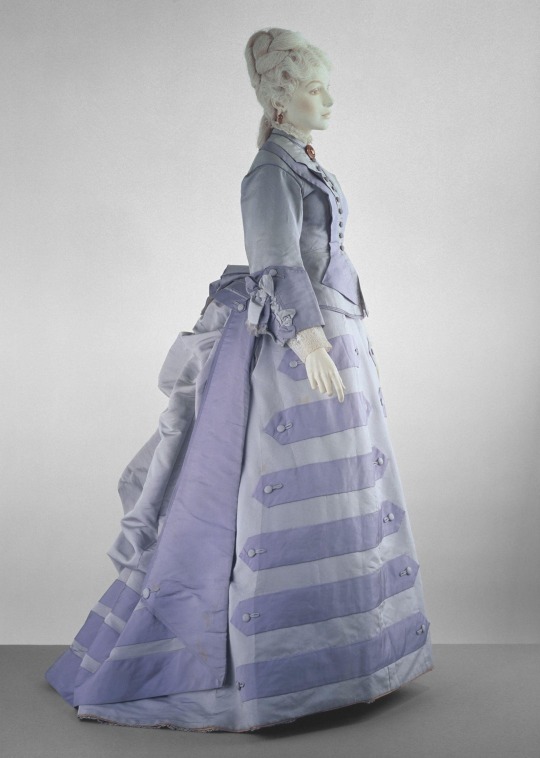
Lilac silk afternoon dress, 1872-1875, British.
Victoria and Albert Museum.
#lilac#purple#womenswear#extant garments#dress#silk#19th century#Britain#1872#V&A#1870s#1870s dress#1870s extant garment#1870s britain#afternoon dress
258 notes
·
View notes
Photo
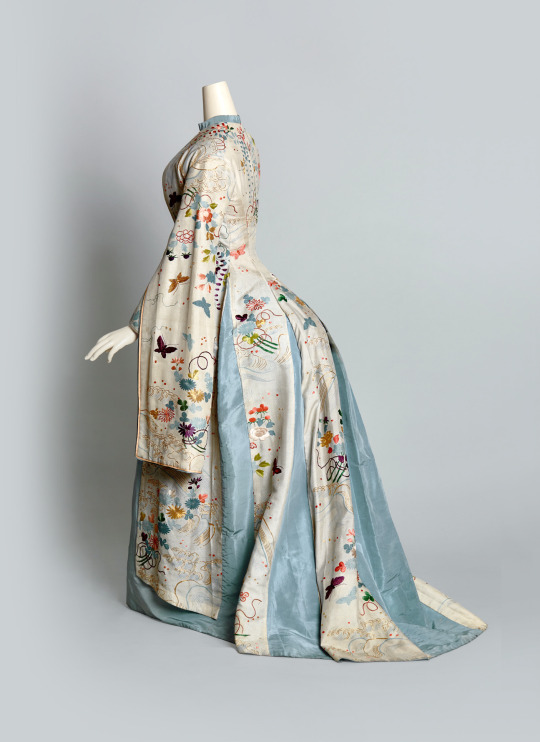

Tea gown ca. 1875-80
From Cora Ginsburg
9K notes
·
View notes
Text
Dressing Katherine Plumber
A comprehensive look at what (historically) Katherine would have likely been wearing on an average weekday.

Combination Underwear
First introduced in the 1870s, women’s combinations were a less bulky alternative to wearing a separate chemise (also known as a shift) and drawers. They are exactly what they sound like- a combination of those two garments.

Combinations had become extremely popular by the late 1890s/early 1900s (in part thanks to the Rational Dress Movement, which advocated for less constricting women’s clothing as well as fewer layers in general). In the late 19th century they were usually made of lightweight fine cotton or muslin, and by the early 20th century they were most often made of silk. Though combinations were not meant to be seen, they were still often decorated with lace and embroidery.
Stockings and Shoes
The first rule of getting dressed in the Victorian and Edwardian eras- put on stockings and shoes before the corset!
Stockings were typically made of silk in the 1890s, and everyday ones were almost always plain black. The only time white stockings were worn was for special occasions and with fancy evening gowns, and these stockings were often decorated as well. Stockings usually ended above the knee and a garter ribbon was often tied just below the knee to help keep them up.

In the late Victorian and Edwardian periods, two-toned cloth-topped button boots were popular everyday shoes. They closed at the side with buttons (zippers had yet to catch on and velcro had yet to be invented) and a button hook would have been used to get them on and off quickly and easily. (As a side note, button hooks were also used by medical inspectors on Ellis Island to flip the inside of a person’s eyelid up to check for eye disease.)

Corset & Corset Cover
We’ve arrived at everyone’s favorite item of historical clothing- the corset.
First, it is important to note that corsets were not meant to be the instruments of torture that they are so often portrayed as, and most women were not tight-lacing down to a 16 or 17-inch waist in their everyday lives. Rather, corsets were meant to be supportive garments which could also give women the classic Victorian and Edwardian silhouettes that were popular at the time. (I won’t go into insane amounts of detail about the history of corsetry in general, but if you’re interested in learning more about it I highly recommend watching this video.)
Katherine likely would have worn a late-Victorian era corset, giving her the hourglass-figure that was popular (if your story takes place more than two years after the events of Newsies, however, Katherine would have worn a more elongated Edwardian style corset).
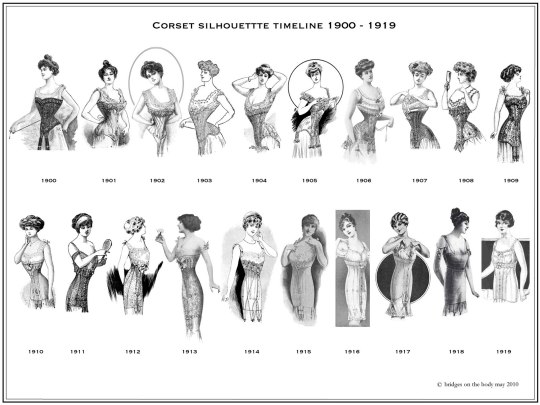
Turn-of-the-century corsets were made of either flexible steel or whalebone and usually covered with either linen or cotton. They could also be embellished with embroidery or other decorations.
Corset covers were worn over the corset itself to protect both the corset and the dress or shirtwaist. They could be plain or decorated and were usually not meant to be seen.

Petticoat(s)
At least one petticoat was worn under the dress (or in the case of Katherine, skirt). They could be plain or decorated, much like all the other undergarments, and often had either added flounces or gores to provide more fullness. They could also be made of a variety of materials- cotton, silk, wool, muslin, etc. For an everyday dress or skirt, Katherine would have likely only worn one petticoat.

Shirtwaist
These next two pieces of clothing are the main outfit themselves and could vary wildly from day-to-day. For our purposes, let's assume that what Katherine wears in the musical is what she wears on a normal workday.
The blouse or shirtwaist was an extremely popular garment for women from all walks of life. They could be as plain or as fancy as a woman wanted. As a member of the upper class, Katherine's would have been more decorated and made of more expensive materials.

Shirtwaists in the 1890s often had the Leg-O'-Mutton sleeves which were popular at the time (think of the puffed sleeves which Anne Shirley longed for in Anne of Green Gables). However, those were becoming smaller and smaller and by 1912 had vanished almost completely in favor of straight sleeves with no pouf.

Shirtwaists were also often worn with stiff, detachable collars, and ties like the one Katherine wears in the show were also popular (especially for white-collar working women).

Walking Skirt
The walking skirt was an extremely popular garment in both the Victorian and Edwardian eras, so much so that it's still synonymous with them today.
Walking skirts, like shirtwaists, varied quite a lot in their fabric and patterns. They could be made of wool or cotton, and the fabric could be one solid color or patterned. Walking skirts also had gores, meaning triangles of fabric were inserted at the seams to give them extra fullness. Circle skirts (with no gores) were popular as well, but the skirt Katherine wears in the musical (and likely would have worn daily) is more similar in style to a walking skirt.

Jacket/Waistcoat
As can be seen in the show, Katherine often wears either a jacket or a waistcoat to complete her outfit. These were indeed popular at the turn of the century and looked quite similar to the ones in the show.
Waistcoats for women were very similar to those for men, although they could be boned to give them a more defined shape. They could be made of a contrasting fabric to the skirt, or a matching one (like Katherine's).
Small bolero jackets (like the one Katherine wears at the beginning of the show) were popular, as were longer jackets. They had the same puffed sleeves as shirtwaists and the bodices of dresses did, and like waistcoats could be made of a contrasting or matching fabric to the skirt or dress (more often matching, however).
Hair
Now for the final part of a woman's outfit- her hairdo.
Katherine's hair in the show would have been out of place in 1899 New York City, to say the least. Women usually wore their hair up in the classic Gibson Girl style, or if they wore it down they would have it in a braid down their back or tied back with a large ribbon. For evening wear and parties, especially, a classic Victorian updo was the way to go.

I hope you've all enjoyed this trip into historical clothing, and that it wasn’t too long or confusing (historical fashion is one of my favorite things to talk about, so I tend to ramble). I'm hoping to post more of these types of things for other characters in the future, and I'm also currently working on compiling a list of good databases of extant garments so that you can see even more examples of historical clothing, which will hopefully be helpful tools for all of you.
Sources:
https://blog.fidmmuseum.org/museum/2010/10/combination-undergarments.html
https://vintagedancer.com/victorian/victorian-stockings-socks-hosiery-tights/
https://fashionhistory.fitnyc.edu/shirtwaist/
61 notes
·
View notes
Text
I'm begging on my knees... what is the difference between 1860s, 1870s and 1880s corsets if there's any... I've been looking at extant garments and illustrations all day and I still can't see what the identifiable characteristics are...
0 notes
Text
this pocket business has me thinking about one of the biggest dress history mysteries I’ve come across
namely, the association between suffragists and pockets
one frequently sees satirical images of women’s suffrage activists with pockets all over their clothing, and male commenters on the movement make much of the suffragist’s apparent obsession with pockets. one writing in 1899 even called women “pocketless”
except. they weren’t
most late Victorian/Edwardian day skirts I’ve seen have at least one pocket, and fairly capacious ones at that. the 1880s pocket I traced my own go-to pocket pattern from measured 9″x11″, and that seems fairly representative based on the extant garments I’ve examined
(this is extremely difficult to find photos of, because nobody displays these skirts- in museums or for sale online -inside-out)
so whence this idea that women had no pockets in the early 20th century, and needed to fight for their right to personal storage space?
I initially thought it was a reaction to the satirical essay “Why We Oppose Pockets For Women,” written in 1915 by Alice Duer Miller and intended to show the nonsense of common arguments against women voting by applying them to something as mundane and universal as pockets. but the whole pocket issue appeared well before Miller published said essay
is it that women’s clothing often had fewer places for pockets than men’s? our coats certainly had them a lot of the time, as far as I can tell. women’s waistcoats of the 1890s and early 1900s often featured watch pockets, as did the waistbands of some of our skirts. but the latter are very small pockets, and I guess some skirts only had one pocket, and not everyone liked waistcoats, so maybe that’s the issue? maybe I’m just coming at this as a 21st-century woman, pathetically excited at the prospect of any pockets at all. maybe the skirt pockets of the 1900s (and 1890s...and 1870s...and 1850s) seemed woefully inadequate to women back then
but. people. 9″x11″
I really don’t understand. there’s a piece of cultural context missing here, I’m sure, that would bring illumination. I pray that someday I find it
#[rachael bloom voice] 'i feel like I'm being gaslighted by the late 19th and early 20th centuries'#dress history#fashion history#pockets#women's pockets#clearly SOMETHING was up pocket-wise but I can't for the life of me see what
257 notes
·
View notes
Text
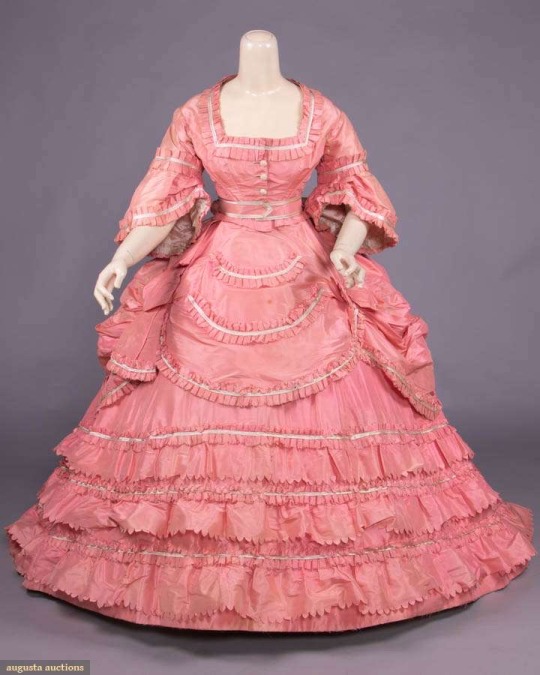
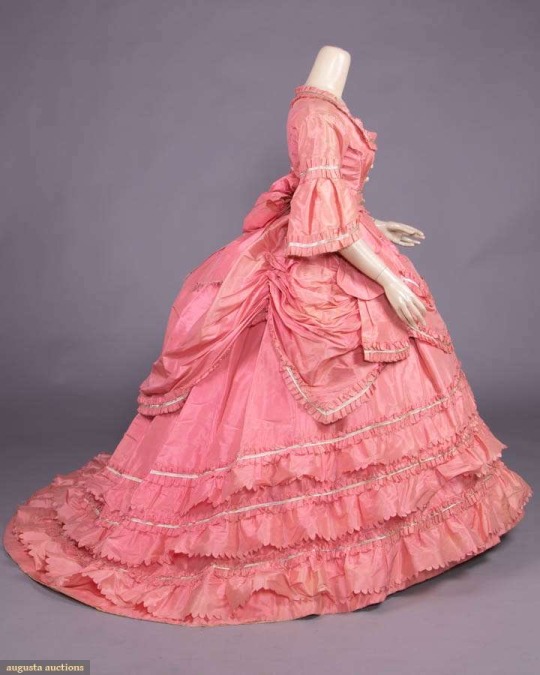
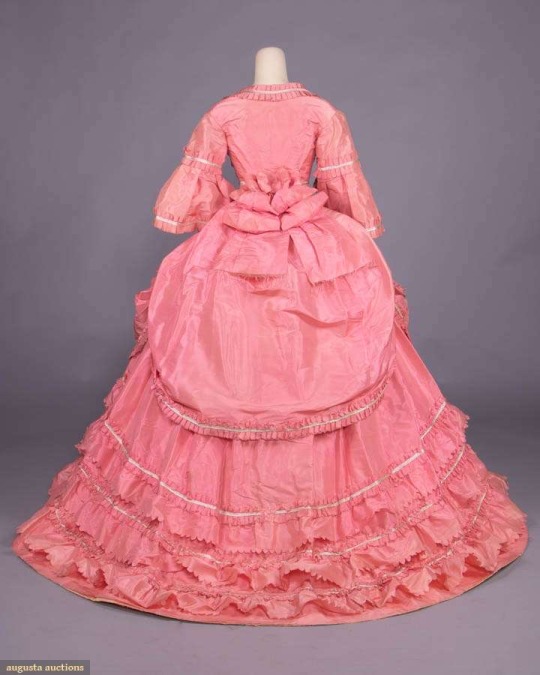
Pink Taffeta Ballgown, ca. 1872.
Augusta Auctions.
#pink#taffeta#womenswear#extant garments#dress#silk#ballgown#19th century#1872#1870s#1870s dress#1870s ballgown#1870s evening#augusta auctions#1870s extant garment
414 notes
·
View notes